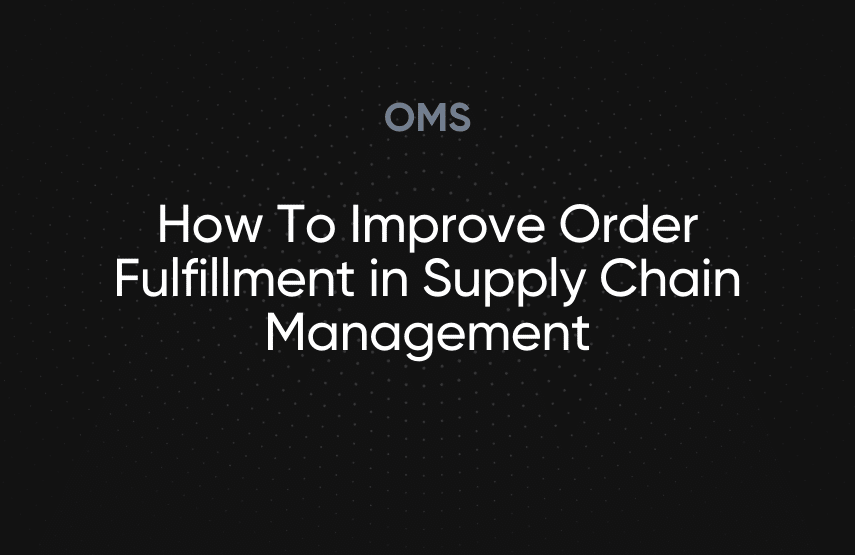How To Improve Order Fulfillment in Supply Chain Management

38% of e-commerce companies handle order fulfillment in-house, while 18% are likely to outsource this process.
Order fulfillment in supply chain management refers to a series of steps that e-commerce companies take to deliver orders on time.
To optimize order fulfillment in supply chain management, merchants must focus on these four key areas: OMS order management, order fulfillment logic (OFL), warehouse management system (WMS), and last mile logistics.
Adopting an effective OMS like fabric OMS can help to improve order fulfillment in supply chain management for e-commerce companies.
A 2018 DHL survey shows that 38% of e-commerce companies handle order fulfillment in-house, while 18% are likely to outsource this process. With increased customer orders containing more diverse SKUs, order fulfillment management has become challenging, requiring unique solutions.
With 69% of consumers less likely to shop with retailers that do not deliver within two days of the date promised, e-commerce companies must coordinate distribution and high delivery costs. Many merchants have a single distribution center that cannot meet increased consumer demands.
To overcome these challenges, e-commerce companies must streamline order fulfillment across every aspect of the sales process. When every part of the supply chain is connected, merchants will know the current status of their inventory, where it is, and when it arrives to plan their business accordingly.
As an integral part of supply chain management, order fulfillment determines how merchants meet customer demands and complete sales accurately. Supply chain management includes four pieces: OMS order management, order fulfillment logic (OFL), warehouse management system (WMS), and last mile logistics.
[toc-embed headline=”OMS Order Management”]
OMS Order Management
OMS order management connects every aspect of supply chain management, from order placement, fulfillment, and delivery. Merchants can use order management system (OMS) software to streamline order fulfillment across their supply chain.
An OMS software supports every aspect of order fulfillment, including inventory management, order tracking, and shipping customer purchases. Choosing a modern order management system (OMS) helps e-commerce companies to coordinate inventory movement with 3PL providers and optimize costs.
[toc-embed headline=”Order Fulfilment Logic (OFL)”]
Order Fulfilment Logic (OFL)
Order fulfillment logic covers the principles and strategies that e-commerce companies deploy to ensure that customers’ orders are processed efficiently. This means that it dictates the pace of fulfillment in the supply chain process.
Order processing is about balancing customer needs with the business’s bottom line. A well laid out order fulfillment logic means e-commerce companies will incur less cost, use their inventory efficiently and provide better customer service.
As more merchants prioritize delivering purchases from multiple distribution centers, there’s a need to develop an order fulfillment logic that enables them to coordinate these deliveries seamlessly. For instance, when setting up distribution centers, merchants need to consider customers’ physical locations and the costs of delivering orders from the said location.
[toc-embed headline=”Warehouse Management System (WMS)”]
Warehouse Management System (WMS)
A warehouse management system is software that automates warehouse operations, including inventory tracking. It simplifies order fulfillment by ensuring that products move through an organization’s warehouse seamlessly.
In the past, e-commerce companies depended on paperwork to track warehousing activities accurately. However, with the growing demands of the e-commerce industry, merchants require an automated and scalable system for monitoring warehouse operations.
Specifically, a warehouse management system helps e-commerce companies to:
- Keep track of goods and raw materials in various warehouses efficiently.
- Stay updated on how orders move along the supply chain, from arrival to when it’s delivered to the customer.
- Process returns efficiently and quickly so customers can track their returns.
[toc-embed headline=”Last Mile Logistics”]
Last Mile Logistics
Last mile logistics make up nearly 28% of a shipment’s total costs. It is the final phase of order fulfillment in supply chain management and is concerned with how e-commerce companies deliver products to consumers faster and cost-effectively. In most cases, merchants use parcels or small package carriers to deliver consumers’ purchases.
Traditionally, e-commerce companies paid little attention to the role of last mile logistics in delivering optimal customer experience. Nowadays, 23% of consumers are willing to pay extra for same-day delivery. Thus merchants must focus on last mile logistics to meet demands.

E-commerce companies face several last mile logistics challenges. First, faster delivery often means incurring higher delivery costs passed down to the consumers. Merchants also have to deal with shipping complexities, staff shortages, and other capacity challenges.
Since these challenges aren’t going away soon, e-commerce companies must learn to build around them to meet consumers’ order fulfillment demands. For instance, investing in last-mile delivery software can help e-commerce companies streamline processes, increase capacity, and boost efficiency.

Tech advocate and writer @ fabric.